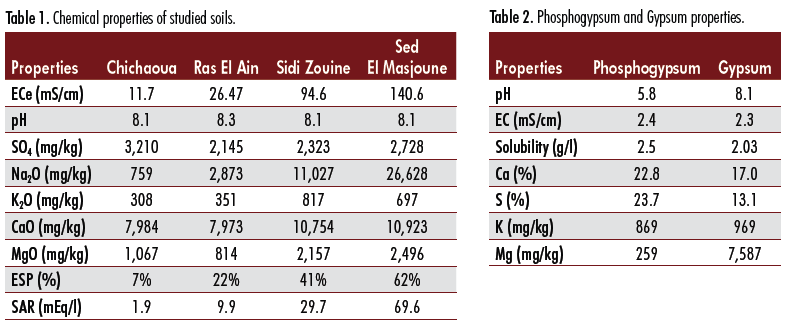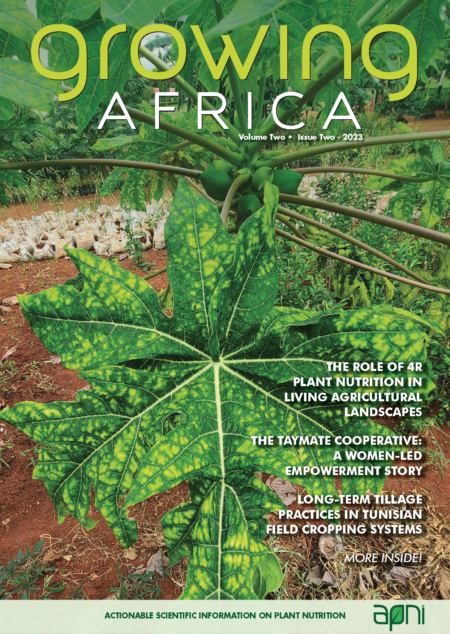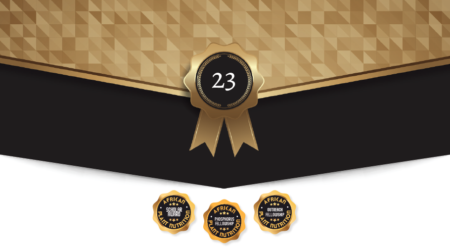By M Barka Outbakat, Khalil El Mejahed, Mohamed El Gharous, Kamal El Omari, and Adnane Beniaich
Salinity presents a major challenge to food security, especially in arid and semi-arid regions. It negatively affects soil chemical and physical properties and ultimately crop yields. The use of phosphogypsum as an affordable amendment is a sustainable approach to overcome the effects of soil salinity. This research demonstrates phosphogypsum’s beneficial impacts on the physical properties of salt-affected soils including improved water aggregate stability, water retention capacity, total porosity, and bulk density.
Soil is a vital natural resource, providing several ecosystem services such as carbon sequestration, water purification, and nutrient cycling. However, soil is susceptible to various forms of physical, chemical, and biological degradation. Soil salinization is one form of chemical degradation that is significantly challenging crop production in arid and semi-arid regions. The presence of salts in the soil rhizosphere induces an osmotic effect that limits the uptake of both water and nutrients by plant roots (Rahneshan et al., 2018).
Salinity reduces the number of chloroplasts in leaf cells and damages the anatomy of the roots and leaves (Hasana and Miyake, 2017). Furthermore, salinity and sodicity harm soil physical properties. It causes soil swelling and erosion (Rengasamy, 2016). Moreover, salinity stress reduces soil water retention and increases soil dispersion, destroying soil aggregate stability (Saidi et al., 2004). The use of inorganic amendments, such as phosphogypsum, is a promising and low-cost strategy for saline-sodic soil reclamation (Outbakat et al., 2022). Phosphogypsum is a coproduct of the phosphate fertilizer industry according to the following reaction:
Ca10(PO2)6F2 + 10H2SO4 + 20H2O → 6H3PO4 + 2HF + 10(CaSO4 • 2H2O)
Integrating phosphogypsum into circular economy models minimizes reliance on conventional disposal methods on land and in the sea. This reduces environmental impact and enhances the overall efficiency and sustainability for phosphogypsum production and use.

Arid and semi-arid conditions dominate Morocco, and the salt-affected soil area is estimated to be 1.148 M ha (FAO, 1988). Morocco is also among the significant phosphogypsum producers in the world. Few studies have evaluated the effect of phosphogypsum on physical properties of saline soils, which is the aim of the research presented below.
Study description
Soil samples were collected from four regions of Morocco: Chichaoua, Ras El Ain, Sidi Zouine, and Sed El Masjoune (Fig. 1). Each soil was classified for their salinity and sodicity status. The soil of Chichaoua is highly saline, while Ras Al Ain, Sidi Zouine, and Sed El Masjoune soils are very strongly saline–sodic (Table 1).

A pot trial was carried out under greenhouse conditions at the experimental farm of Mohammed VI Polytechnic University (UM6P) in Ben Guerir, Morocco. Each pot was filled with 10 kg of soil. The soil amendments included Moroccan phosphogypsum (PG) and natural gypsum (G) (Table 2). The treatments included a control, 15, 30, and 45 t/ha of PG, and 15 t/ha of G.


Soil physical evaluation
Soil physical properties were assessed after a Faba bean harvest. Soil bulk density (BD) was determined according to the method proposed by Blake and Hartge (2018). The saturated volumetric soil water content was used to determine total porosity (TP). Soil water aggregate stability (WAS) was measured using the wet sieving apparatus, while a pressure plate apparatus was used to determine field capacity (FC) and permanent wilting point (PWP) (Fig. 2). The available water capacity (AWC) for plants was estimated according to the following equation:
AWC = FC – PWP

Water Aggregate Stability and Available Water Capacity
Fig. 3 shows the linear regression between phosphogypsum application rate and water aggregate stability for all studied soils. In fact, WAS increased, with a high coefficient of determination (R2=93.41%) as the phosphogypsum dose rose. Phosphogypsum affects soil aggregation by ensuring cation and electrolyte concentration balance in the soil. It can also alter the soil’s susceptibility to dispersion by impacting the balance between attractive and repulsive forces at the soil-water interface.

Phosphogypsum application enhanced the available water capacity, especially in the Chichaoua and Ras El Ain soils (data not shown). This increase in soil water retention is attributed to sodium substitution by the calcium contained within the phosphogypsum (Melo et al., 2008).
The lyotropic series of cations presents the relative strength of ion adsorption onto clay fraction for the principal cations in the soil (i.e., Ca2+ > Mg2+ > K+ ≈ NH4+ > Na+). The application of phosphogypsum introduces a high concentration of calcium, and since sodium is in the last position in this sequence, it is easily replaced by calcium due to valence and low adsorption selectivity (Fig. 4).

Soil Porosity and Bulk Density
The relative impact of phosphogypsum on total soil porosity is different between soil types, but overall, its application had a positive effect on TP (Fig. 5). For instance, in Chichaoua, TP was 8% greater than the untreated control with the application of 30 t PG/ha. However, in Ras El Ain, 45 t PG/ha resulted in an 8% increase in TP compared to the control. A decrease in soil bulk density was only observed in Chichaoua where it was 5% lower than the control if amended with 45 t PG/ ha (Fig. 6).


Phosphogypsum was similar to gypsum in its capacity to improve soil physical properties. However, evidence suggests cases where it was more effective, which is possibly explained by phosphogypsum’s potential to promote greater calcium and sulfate concentrations than gypsum (Table 2). Furthermore, the acidifying effect of phosphogypsum can enhance the solubilization of soil calcium carbonates and further improve Ca2+ concentrations in the soil. Since the demand for natural gypsum is increasing, phosphogypsum can be a viable alternative to alleviate any demand-driven pressures on natural resources. n
Summary
Phosphogypsum application enhanced the structure of salt-affected soils by improving water aggregate stability, water retention, total porosity, and decreasing bulk density. Improving the soil’s physical properties can enhance the growth of below and aboveground biomass, and the development of harvestable crop products, especially in arid and semiarid areas. Therefore, phosphogypsum could revitalize salt-affected soils into productive and resilient ecosystems, promoting sustainable land management practices.
Acknowledgment
This article is adapted from Outbakat, M.B., El Mejahed, K., El Gharous, M., El Omari, K., Beniaich, A. 2022. Effect of Phosphogypsum on Soil Physical Properties in Moroccan Salt-Affected Soils. Sustainability 14, 13087. https://doi.org/10.3390/su142013087. This research was financially supported by OCP under the specific agreement “AS 49”.
Ms. Outbakat is a Doctoral Student, Agricultural Innovation and Technology Transfer Center (AITTC), College of Sustainable Agriculture and Environmental Sciences (CAES), Mohammed VI Polytechnic University (UM6P), Ben Guerir, Morocco. Dr. El Mejahed is Professor, AITTC/ CAES/UM6P. Dr. El Gharous is Director, AITTC. Dr. Beniaich, Research and Education Fellow, AITTC/ CAES/UM6P. Mr. El Omari is with OCP S.A., Sustainability & Green Industrial Development (SGID), Casablanca, Morocco.
Cite this article
Outbakat, M.B., El Mejahed, K., El Gharous, M., El Omari, K., Beniaich, A. 2023. Phosphogypsum Application Improves the Physical Properties of Salt-Affected Soils, Growing Africa 2(2), 26-31. https://doi.org/10.55693/ga22.JMFT3208
REFERENCES
Blake, G.R., Hartge, K.H. 2018. Bulk Density, In, Methods of Soil Analysis, Part 1: Physical and Mineralogical Properties, Including Statistics of Measurement and Sampling, 363-375. doi: 10.2136/sssabookser5.1.2ed.c13.
Hasana, R., Miyake, H. 2017. Salinity Stress Alters Nutrient Uptake and Causes the Damage of Root and Leaf Anatomy in Maize. KnE Life Sci. 3, 219. doi: 10.18502/kls.v3i4.708.
FAO. 1988. Salt-Affected Soils and Their Management Soils Bulletin 39. Available online: http://www.fao.org/3/x5871e/x587 1e00.htm
Melo, R.M., Barros, M. de F.C., Santos, P.M. dos, and Rolim, M.M. 2008. Correção de solos salino-sódicos pela aplicação de gesso mineral. Rev. Bras. Eng. Agrícola e Ambient. 12, 376-380. doi: 10.1590/s1415-43662008000400007.
Mesić, M. 2016. The Application of Phosphogypsum in Agriculture. 81, 7-13.
Outbakat, M.B., et al. 2022. Does phosphogypsum application affect salts , nutrients , and trace elements displacement from saline soils ? Front. Environ. Sci. 1–14. doi: 10.3389/fenvs.2022.964698.
Rahneshan, Z., Nasibi, F., Moghadam, A.A. 2018. Effects of salinity stress on some growth, physiological, biochemical parameters and nutrients in two pistachio (Pistacia vera L.) rootstocks. J. Plant Interact. 13, 73–82. doi: 10.1080/17429145.2018.1424355.
Rengasamy, P. 2016. Soil chemistry factors confounding crop salinity tolerance-a review. Agronomy 6. doi: 10.3390/agronomy6040053.
Saidi, D., et al. 2004. Effet du sodium échangeable et de la concentration saline sur les propriétés physiques des sols de la plaine du Cheliff (Algérie). Gestion 11, 81-92.




